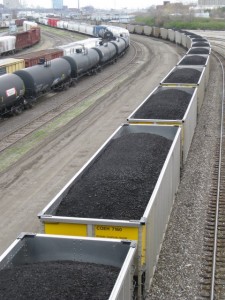Most people don’t think much about how their electricity is produced. It turns out that half of the electricity in the United States is produced by burning coal. Maybe you’re thinking “So what?”
Here’s why you should care. There is no such thing as “clean coal,” it is still a fantasy, not a reality. Mining coal releases dangerous amounts of mercury into the human environment, including 48 tons of mercury, “the largest source of man-made mercury pollution in the U.S.” Burning coal releases massive amounts of carbon dioxide. Coal is dangerous. And see here.

In the United States, we burn a railroad car worth of coal every 3 seconds. This year, your family will burn 1,000 pounds of coal just to run your clothes dryer (yet many communities make it illegal to dry your clothes on a line outside).
Each year, a 500 megawatt coal plant burns 1.4 million tons of coal. It also produces:
- 125,000 tons of ash and 193,000 tons of sludge from the smokestack scrubber. A scrubber uses powdered limestone and water to remove pollution from the plant’s exhaust. Instead of going into the air, the pollution goes into a landfill or into products like concrete and drywall. This ash and sludge consists of coal ash, limestone, and many pollutants, such as toxic metals like lead and mercury.
- 225 pounds of arsenic, 114 pounds of lead, 4 pounds of cadmium, and many other toxic heavy metals. Mercury emissions from coal plants are suspected of contaminating lakes and rivers in northern and northeast states and Canada. In Wisconsin alone, more than 200 lakes and rivers are contaminated with mercury. Health officials warn against eating fish caught in these waters, since mercury can cause birth defects, brain damage and other ailments. Acid rain also causes mercury poisoning by leaching mercury from rocks and making it available in a form that can be taken up by organisms.
- Tons of hazardous and acidic waste which can contaminate ground water. Strip mining also destroys habitat and can affect water tables.
Again, how much coal did you burn today? If you live in an area where most of the electricity comes from coal, the amount of coal you burn will astound you. Your family burned 30 pounds of coal today. And you’ll burn another 30 pounds tomorrow. And the next day.
The average household in the U.S buys, on average, 900 kWh of electricity per month, roughly every 30 days. If we multiply 30 days times 24 hours, we find that there are 720 hours in a month. The average household, therefore, is responsible for consuming 1.25 pounds of coal per hour (900 kWh = 900 pounds divided by 720 hours). (Note: your mileage may vary, as we are assuming an ‘average’ house here. Check your utility bill for the past 12 months for your actual kilowatt-hour usage.) There are 8,760 hours in a year, so if we multiply 1.25 pounds by 8,760, we find that the ‘average’ house using 100% coal-generated electricity is responsible for the burning of 10,950 pounds of coal for the electricity they consume per year. That’s nearly 5.5 tons!
The question, then, is why we don’t work harder to be more energy efficient? We could construct buildings that are close to carbon neutral (and see here). We could massively reduce our energy use without reducing our quality of life. Each of us could help in dozens of easy ways. Consider, too, that peak coal is approaching; don’t believe the hype that there are many decades of cheap coal left. With all of these problems with coal, why does the U.S. Department of Energy website tout the virtues of coal without disclosing the dangers? Why doesn’t the DOE discuss energy conservation as a means of drastically reducing the amount of coal we burn? The logic is indisputable: Those areas of the country that depend heavily on coal could cut the trainloads of coal they burn in half if they cut their use of electricity in half. There are easy ways to cut the our use of energy (and see here).
We could live smart, if only we had the will, if only we would take the time to consider that there are far better options. If only we thought about it, we would realize that our energy-wasteful habits are killing American industry. Unfortunately, we live in a country that doesn’t know how to stop bad things from happening and to make good things happen. We are squandering our future. It’s pathetic for a country that talks such a big game to fail so miserably.
Isn’t it time to start writing a happier ending to this sad story? Here’s how. Talk to your friends and neighbors about the dangers of coal. Take the time to learn more about coal. Read this Sierra Club publication: The Dirty Truth About Coal. And when you’re trying to decide who to believe, remember that the Sierra Club isn’t trying to make a profit, unlike those who want to burn ever-larger amounts of coal.


"Bill Gates discussed the urgent need to produce clean energy at TED, and coal is not part of the picture. Gates said the deadline for the world to cut all of its carbon emissions is 2050. He suggested that researchers spend the next 20 years inventing and perfecting clean-energy technologies, and then the next 20 years implementing them."
http://www.huffingtonpost.com/2010/02/12/bill-gat…
The world's energy portfolio should not include coal or natural gas, he said, and must include carbon capture and storage technology as well as nuclear, wind and both solar photovoltaics and solar thermal power.